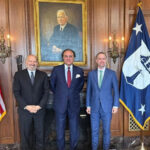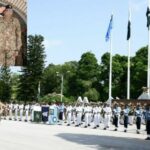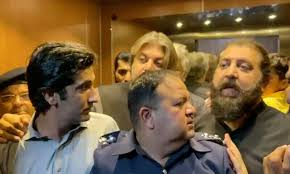Iran’s Supreme Leader, Ayatollah Ali Khamenei, publicly dismissed American claims that recent US-led airstrikes had inflicted serious damage on Iran’s nuclear programme. In a televised address on Thursday, Khamenei declared that the strikes “gained no achievements” and warned of potential future retaliation if Iran’s sovereignty is threatened again.
This was Khamenei’s first appearance since direct conflict between Iran and Israel broke out on June 13, escalating into a broader regional confrontation that pulled the United States directly into the conflict. Khamenei, who had not been seen publicly for over a week, issued a stark rebuke of American and Israeli narratives, describing the retaliatory Iranian missile strike on a US base in Qatar as a “heavy blow” and a signal of Iran’s regional reach.
The US had launched coordinated strikes on three of Iran’s key nuclear facilities – Fordo, Natanz, and Isfahan – in what it described as a precision operation to cripple Tehran’s ability to enrich uranium. However, the Iranian leadership strongly denies the effectiveness of the operation. Khamenei asserted that the nuclear program remains intact and operational.
“The enemies could not accomplish anything significant,” Khamenei said during the address. “Their goal was to paralyze our nuclear capabilities, but they failed completely. This is a lesson for all aggressors.”
Despite US President Donald Trump’s claims that the nuclear sites were “totally obliterated,” and Defence Secretary Pete Hegseth’s assertion that the facilities were rendered “inoperable,” Iranian officials maintain that no critical infrastructure was permanently damaged. According to Khamenei, any attempts by the US to showcase this operation as a strategic victory are “exaggerations designed for internal political consumption.”

The Fordo site, a deeply buried enrichment facility near Qom, was one of the primary targets. US officials insist it was struck by bunker-buster bombs and is now inoperable. However, Iran has not allowed independent verification, and no images or third-party intelligence have confirmed the claimed extent of the damage. In fact, concerns have surfaced from international watchdogs that Iran may have moved enriched uranium out of the site in advance of the strikes.
Adding to regional instability, Iran’s Parliament approved a bill on Thursday to end cooperation with the International Atomic Energy Agency (IAEA). This decision effectively shuts down the presence of international nuclear inspectors in Iran and further complicates global non-proliferation monitoring efforts. This move comes after the IAEA’s Board of Governors declared Iran in breach of its commitments for the first time in two decades.
Iran has long maintained that its nuclear program is strictly for peaceful, civilian purposes. It denies any ambition to develop nuclear weapons. Yet the timing of the bill, alongside escalating tensions and military actions, raises questions among international observers about Tehran’s intentions.
The recent military exchange began when Israeli Prime Minister Benjamin Netanyahu publicly warned that Iran was on the verge of obtaining a nuclear weapon. Israel’s subsequent strikes prompted retaliatory actions from Tehran, including missile attacks on Israeli cities and the US air base in Qatar. Although the attack on the US base caused no casualties or reported structural damage, Khamenei emphasized that it was a warning shot – one that could be repeated with greater intensity.
“This incident is also repeatable in the future,” Khamenei warned. “Should any attack take place, the cost for the aggressor will be very high.”
Iran’s health ministry reported that 610 people were killed during the 12 days of air assaults. In contrast, Israeli authorities stated that 28 of their citizens were killed in the conflict. These figures underscore the uneven toll the conflict has taken and fuel anger in Tehran over what it perceives as Western complicity in regional violence.
Amid rising casualties and fears of broader escalation, a ceasefire agreement was brokered earlier this week, reportedly with US mediation. However, both sides remain on high alert, and sporadic incidents continue to threaten the truce.
The US continues to claim success. At a Pentagon press conference, Secretary Hegseth maintained that “the mission was a historic success,” adding that the operation would “set Iran’s nuclear ambitions back by years.” Yet independent observers, including UN nuclear watchdog chief Rafael Grossi, have questioned the scale of the setback, noting that there remains a possibility that Iran moved critical uranium stockpiles ahead of the strike.
Khamenei ended his address by asserting that Iran emerged stronger and more united in the face of aggression. While his rhetoric may be designed for internal solidarity, it also signals Tehran’s intent to continue resisting US pressure, both militarily and diplomatically.
As the Middle East grapples with another precarious chapter, the world watches closely. The lack of transparency around nuclear site damage, combined with Tehran’s decision to sever ties with international nuclear inspectors, raises new questions about global non-proliferation enforcement.
Whether or not the US achieved tactical success in the strikes, the strategic landscape has shifted — one that now includes fewer diplomatic channels and a re-energized Iranian leadership determined to assert its independence on the world stage.
#IranUSConflict #Khamenei #NuclearStrikeResponse #IranNuclearProgram #MiddleEastTensions #Fordo #Natanz #Isfahan #AyatollahKhamenei #IranIsraelConflict

















